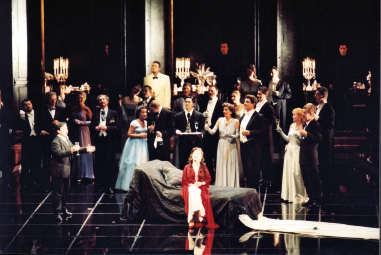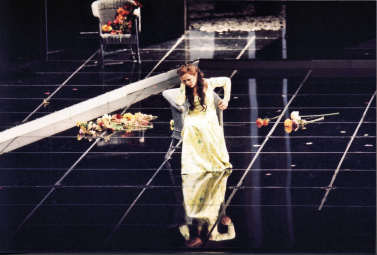|
Editorial Board
Melanie
Eskenazi
Webmaster: Len Mullenger
|
Seen and Heard International
Opera Review
VERDI
La traviata at Deutsche Oper Berlin, 09.11. 2006 (GF) Directed by Götz Friedrich Sets by Frank Philipp Schlössmann Costumes by Klaus Bruns Light design by Ulrich Niepel Cast: Violetta Valery – Andrea Rost Alfredo Germont – Roberto Aronica Giorgio
Germont – Roberto Frontali Flora
Bervoix – Sarah van der Kemp Annina
– Andion Fernandez Gaston – Jörg Schörner Baron Douphol – Lenus Carlson Marquis d’Obigny – Harold Wilson Doctor Grenvil – Ante Jerkunica Giuseppe – Paul Kaufmann A messenger – Hyung-Wook Lee Chorus and Orchestra of Deutsche Oper Berlin/Yves Abel
The basic setting is a large room with high doors on all the walls, doors that are opened or closed for specific purposes and through which important background acting is shown. During the prelude to the first act Violetta, dressed in white, is lying on a white bed centre stage and one immediately understands that this is her deathbed. She is gradually more and more spotlit and when the party music for act one begins she rises and gets dressed by Annina in a red robe, the bed is transformed into a canapé and the guests enter. It is hard to decide in what decade Friedrich has placed the action but it could well be mid-20th century. The bed – in various shapes – is omni-present during the whole opera and at the end of the big party scene at Flora’s, after Violetta has been humiliated by Alfredo, she removes the red cover from the – then – sofa and the white bed is there as a preparation for the last act when it is again centre stage. Red is turned white, life is turned death.
In the second act when Giorgio Germont makes his entrance
he is first seen through one of the back doors together
with his daughter, whose existence and coming marriage
is the main reason for Germont’s wish to make Violetta
repudiate Alfredo. During the whole scene, so central
to this opera, she is seen time and again walking nervously
back and forth and occasionally looking in through the
half open doors. Violetta, in the first act dressed
in red, the colour of life and – possibly – sin, in
the second act wears a domestic bleak-yellow dress while
in the Flora scene she is innocently white and her hair
strictly tight-fitting. In the last act the off stage
chorus, merrily celebrating the carnival, is introduced
by colourful fireworks and three gigantic figures, in
carnival dress but with death’s heads, appearing through
the open doors render the scene a nightmarish presage
of death. The whole production – with the interval between the
two scenes of act two, implying that the second half
starts with the party at Flora’s – has you completely
engrossed from beginning to end and the musical side
doesn’t let things down. At the centre of the proceedings
is of course Violetta, endearingly acted and sung by
Andrea Rost. She is by some distance the most beautiful
Violetta I have seen and she perfectly illustrates the
different phases of the poor demi-monde’s decline. Her
basically very appealing voice has a quick flicker that
can sometimes be a little too prominent but especially
in this role it also gives a sense of vulnerability.
This vibrato has widened a mite since I first heard
her, in the beginning of her career, as Lucia in In the minor parts Sarah van der Kamp is an attractive
Flora with great stage presence and the experienced
Lenus Carlson creates an authoritative Baron Douphol.
Yves Abel leads a well paced performance and the chorus
and the extras act convincingly in the two party scenes
where especially the Flora scene is full of life and
entertaining gags. All in all then a La
traviata that will be long remembered for the wide
ranging direction and excellent singing and acting from
all involved.
Back to the Top Back to the Index Page |
| ||
|
||||




